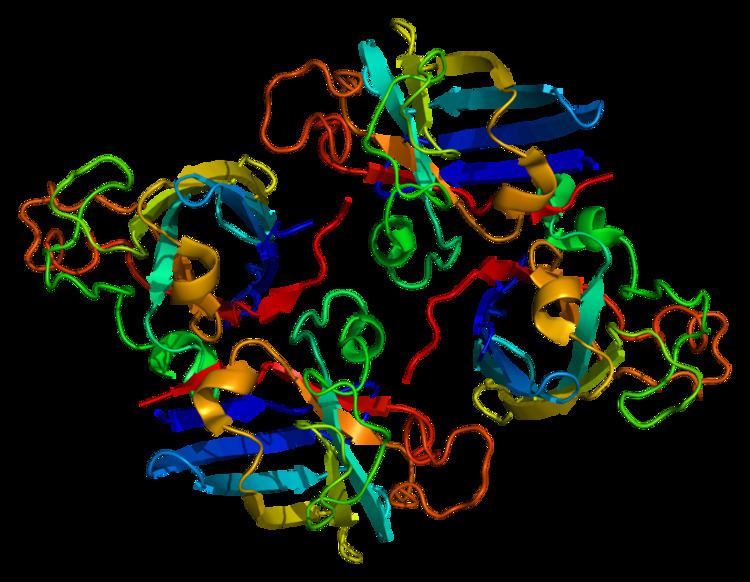Aliases CCS Ensembl ENSG00000173992 | Entrez 9973 | |
 | ||
External IDs MGI: 1333783 HomoloGene: 3762 GeneCards: CCS | ||
Copper chaperone for superoxide dismutase is a metalloprotein that is responsible for the delivery of Cu to superoxide dismutase (SOD1). CCS is a 54kDa protein that is present in mammals and most eukaryotes including yeast. The structure of CCS is composed of three distinct domains that are necessary for its function. Although CCS is important for many organisms, there are CCS independent pathways for SOD1, and many species lack CCS all together, such as C. elegans. In humans the protein is encoded by the CCS gene.
Contents
Structure and function
CCS is composed of three domains. Domain I is located on the N-terminus and contains the MXCXXC Cu binding sequence. It has been determined to be necessary for function of CSS but its specific role is currently unknown. The structure of domain II greatly resembles that of SOD1 which allows it to perform the function of binding to SOD1. Domain III contains a CXC Cu binding motif and performs the Cu insertion and subsequent disulfide oxidation of SOD1.
When CCS docks to SOD1, cysteine 244 of CCS and 57 of SOD1 form a disulfide linkage. This disulfide bond is then transferred to form a disulfide bridge between cysteine 57 and 146 of SOD1. CCS's catalytic oxidation of SOD1's disulfide bridge can only be performed in the presence of oxygen. Furthermore, the disulfide linkage of SOD1 can be performed without the presence of CCS but requires oxygen and is much slower. Additionally, CCS is proposed to help the proper folding of SOD1 by binding in the apo-state.
As well as SOD1, CCS (gene) has been shown to interact with APBA1.
Localization
CCS is localized in the nucleus, cystosol, and mitochondrial intermembrane space. CCS is imported to the mitochondria by Mia40 and Erv1 disulfide relay system. The cysteine 64 of CCS Domain I generates a disulfide intermediate with Mia40. This disulfide bond is transferred to link cysteine 64 and 27 of CCS, stabilizing the protein in the mitochondrial intermembrane space where it delivers Cu to the Cu-less apo-SOD1.
Role in copper homeostasis
In mammals cellular Cu levels are regulated by CCS's interaction with the 26S proteasome. During times of Cu excess CCS delivers Cu to XIAP and primes the complex for auto-ubiquitination and subsequent degradation. Interestingly, expression of SOD1 is not modified by Cu availability but by CCS ability to deliver Cu. Knockouts of CCS (Δccs) show 70-90% decrease in SOD1 activity as well as increased expression of Cu binding proteins, namely, MT-I, MT-II, ATOX1, COX17, ATP7A to, presumably, reduce the amount of free Cu.
Cells with CCS mutants have been shown to display ALS like symptoms. Moreover, SOD1 mutants that have altered interactions with CCS have been shown to display misfolding and aggregation.
